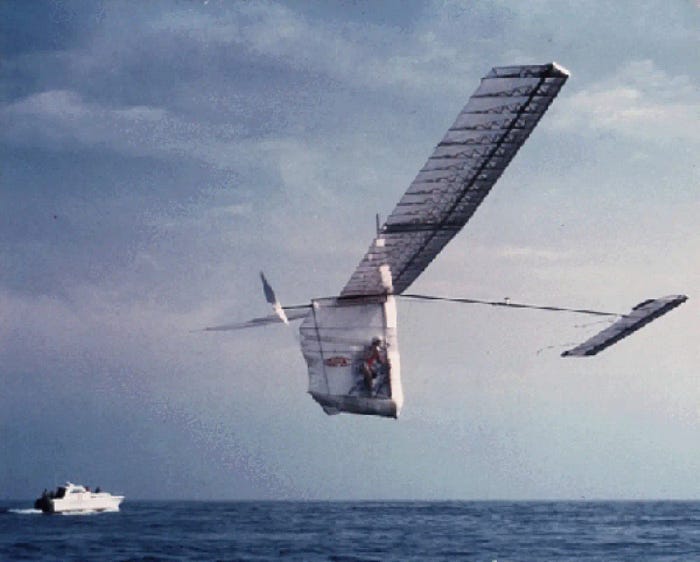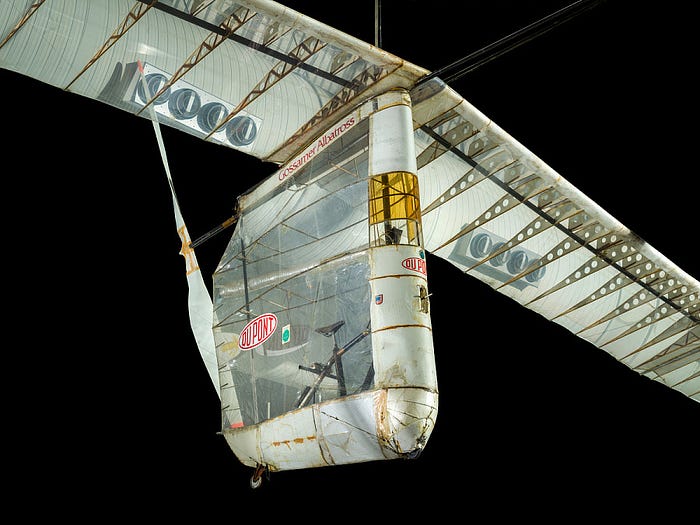Gossamer Albatross
The Gossamer Albatross is an aircraft designed and built by Dr. Paul MacCready and his team at AeroVironment. The Gossamer Albatross is the first human-powered aircraft to complete a sustained flight across the English Channel.
The Gossamer Albatross was specifically designed for the Kremer Prize, a challenge established in 1959 by Henry Kremer to stimulate the development of human-powered aircraft capable of completing a figure-eight course with a total length of one mile. The goal was to encourage advancements in lightweight materials and efficient aerodynamic design.

On June 12, 1979, the Gossamer Albatross successfully flew across the English Channel, piloted by cyclist and amateur pilot Bryan Allen. The flight covered a distance of 22.25 miles (35.8 kilometers) and took just under three hours to complete. This achievement showcased the potential of human-powered flight and marked a significant milestone in aviation history.
The Gossamer Albatross had a wingspan of 96 feet (29 meters) and was constructed using lightweight materials such as carbon fiber and Mylar. It featured a pedal-driven propeller and was powered solely by human effort. The aircraft’s design prioritized aerodynamic efficiency and minimized weight to optimize performance.
The success of the Gossamer Albatross demonstrated the feasibility of human-powered flight and pushed the boundaries of what was previously thought possible. It also laid the groundwork for subsequent advancements in human- and solar-powered aircraft.
Dr. Paul MacCready, the designer of the Gossamer Albatross, went on to make further contributions to aviation, including the development of solar-powered aircraft and other innovative projects.

The General Specifications of Gossamer Albatross
· Crew: One (pilot-engine)
· Capacity: 145-pound (66 kg) useful load
· Length: 34 ft 0 in (10.36 m)
· Wingspan: 97 ft 8 in (29.77 m)
· Height: 16 ft 0 in (4.88 m)
· Wing area: 488 sq ft (45.3 m2)
· Aspect ratio: 19.5
· Empty weight: 70 lb (32 kg)
· Gross weight: 215 lb (98 kg)
· Powerplant: 1 × Human
Performance
· Maximum speed: 18 mph (29 km/h, 16 km)
· Range: 35 mi (56 km, 30 nmi)
· Wing loading: 0.44 lb/sq ft (2.1 kg/m2)

ACHIEVEMENTS
Kremer Prize: The successful Channel crossing flight by the Gossamer Albatross won the Kremer Prize, which was a cash award of £100,000 offered by British industrialist Henry Kremer. The prize was established to encourage the development of human-powered flight.
The MacCready Gossamer Albatross was a remarkable engineering achievement that pushed the boundaries of human-powered flight and demonstrated the potential of sustainable aviation. Its success paved the way for further advancements in this field and inspired subsequent projects in human-powered flight.

